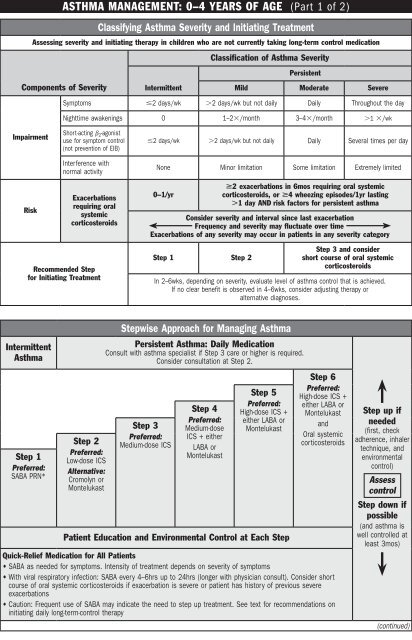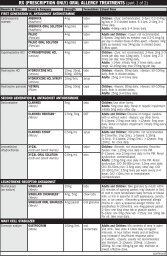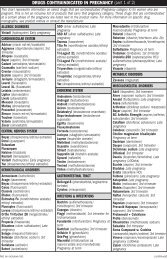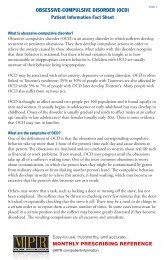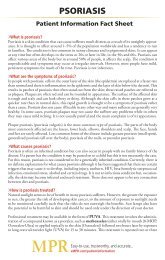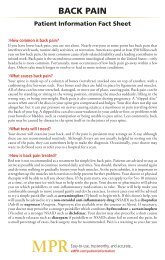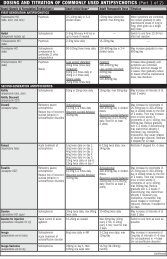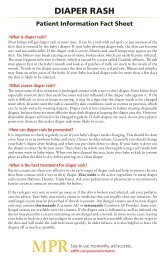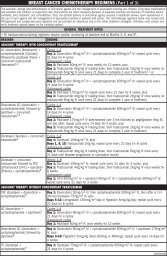ASTHMA MANAGEMENT: 0–4 YEARS OF AGE (Part 1 of 2) - MPR
ASTHMA MANAGEMENT: 0–4 YEARS OF AGE (Part 1 of 2) - MPR
ASTHMA MANAGEMENT: 0–4 YEARS OF AGE (Part 1 of 2) - MPR
You also want an ePaper? Increase the reach of your titles
YUMPU automatically turns print PDFs into web optimized ePapers that Google loves.
<strong>ASTHMA</strong> <strong>MAN<strong>AGE</strong>MENT</strong>: <strong>0–4</strong> <strong>YEARS</strong> <strong>OF</strong> <strong>AGE</strong> (<strong>Part</strong> 1 <strong>of</strong> 2)<br />
Classifying Asthma Severity and Initiating Treatment<br />
Assessing severity and initiating therapy in children who are not currently taking long-term control medication<br />
Classification <strong>of</strong> Asthma Severity<br />
Persistent<br />
Components <strong>of</strong> Severity Intermittent<br />
Mild Moderate Severe<br />
Symptoms 2 days/wk 2 days/wk but not daily Daily Throughout the day<br />
Nighttime awakenings 0 1–2/month 3–4/month 1 /wk<br />
Impairment<br />
Short-acting 2 -agonist<br />
use for symptom control<br />
(not prevention <strong>of</strong> EIB)<br />
Interference with<br />
normal activity<br />
2 days/wk 2 days/wk but not daily Daily Several times per day<br />
None Minor limitation Some limitation Extremely limited<br />
Risk<br />
Exacerbations<br />
requiring oral<br />
systemic<br />
corticosteroids<br />
Recommended Step<br />
for Initiating Treatment<br />
2 exacerbations in 6mos requiring oral systemic<br />
0–1/yr<br />
corticosteroids, or 4 wheezing episodes/1yr lasting<br />
1 day AND risk factors for persistent asthma<br />
Consider severity and interval since last exacerbation<br />
Frequency and severity may fluctuate over time<br />
Exacerbations <strong>of</strong> any severity may occur in patients in any severity category<br />
Step 1 Step 2<br />
Step 3 and consider<br />
short course <strong>of</strong> oral systemic<br />
corticosteroids<br />
In 2–6wks, depending on severity, evaluate level <strong>of</strong> asthma control that is achieved.<br />
If no clear benefit is observed in 4–6wks, consider adjusting therapy or<br />
alternative diagnoses.<br />
Intermittent<br />
Asthma<br />
Step 1<br />
Preferred:<br />
SABA PRN*<br />
Step 2<br />
Preferred:<br />
Low-dose ICS<br />
Alternative:<br />
Cromolyn or<br />
Montelukast<br />
Stepwise Approach for Managing Asthma<br />
Persistent Asthma: Daily Medication<br />
Consult with asthma specialist if Step 3 care or higher is required.<br />
Consider consultation at Step 2.<br />
Step 3<br />
Preferred:<br />
Medium-dose ICS<br />
Step 4<br />
Preferred:<br />
Medium-dose<br />
ICS + either<br />
LABA or<br />
Montelukast<br />
Step 5<br />
Preferred:<br />
High-dose ICS +<br />
either LABA or<br />
Montelukast<br />
Patient Education and Environmental Control at Each Step<br />
Step 6<br />
Preferred:<br />
High-dose ICS +<br />
either LABA or<br />
Montelukast<br />
and<br />
Oral systemic<br />
corticosteroids<br />
Quick-Relief Medication for All Patients<br />
• SABA as needed for symptoms. Intensity <strong>of</strong> treatment depends on severity <strong>of</strong> symptoms<br />
• With viral respiratory infection: SABA every 4–6hrs up to 24hrs (longer with physician consult). Consider short<br />
course <strong>of</strong> oral systemic corticosteroids if exacerbation is severe or patient has history <strong>of</strong> previous severe<br />
exacerbations<br />
• Caution: Frequent use <strong>of</strong> SABA may indicate the need to step up treatment. See text for recommendations on<br />
initiating daily long-term-control therapy<br />
Step up if<br />
needed<br />
(first, check<br />
adherence, inhaler<br />
technique, and<br />
environmental<br />
control)<br />
Assess<br />
control<br />
Step down if<br />
possible<br />
(and asthma is<br />
well controlled at<br />
least 3mos)<br />
(continued)
Impairment<br />
Risk<br />
<strong>ASTHMA</strong> <strong>MAN<strong>AGE</strong>MENT</strong>: <strong>0–4</strong> <strong>YEARS</strong> <strong>OF</strong> <strong>AGE</strong> (<strong>Part</strong> 2 <strong>of</strong> 2)<br />
Assessing Asthma Control and Adjusting Therapy<br />
Classification <strong>of</strong> Asthma Control<br />
Not Well<br />
Components <strong>of</strong> Control Well Controlled Controlled<br />
Very Poorly<br />
Controlled<br />
Symptoms 2 days/wk 2 days/wk Throughout the day<br />
Nighttime awakenings 1/month 1/month 1/wk<br />
Interference with normal activity None Some limitation Extremely limited<br />
Short-acting 2 -agonist use for<br />
symptom control (not prevention<br />
<strong>of</strong> EIB)<br />
2 days/wk 2 days/week Several times per day<br />
Exacerbations requiring oral<br />
systemic corticosteroids<br />
0–1/yr 2–3/yr 3/yr<br />
Treatment-related adverse effects<br />
Recommended Action<br />
for Treatment<br />
Medication side effects can vary in intensity from none to very troublesome and<br />
worrisome. The level <strong>of</strong> intensity does not correlate to specific levels <strong>of</strong> control but should<br />
be considered in the overall assessment <strong>of</strong> risk.<br />
• Maintain current treatment<br />
• Regular follow-up every<br />
1–6mos<br />
• Consider step down if well<br />
controlled for at least 3mos<br />
• Step up—1 step—and<br />
• Reevaluate in 2–6wks<br />
• If no clear benefit in 4–6wks,<br />
consider alternative diagnoses<br />
or adjusting therapy<br />
• For side effects, consider<br />
alternative treatment options<br />
• Consider short course <strong>of</strong> oral<br />
systemic corticosteroids<br />
• Step up—1–2 steps—and<br />
• Reevaluate in 2wks<br />
• If no clear benefit in 4–6wks,<br />
consider alternative diagnoses<br />
or adjusting therapy<br />
• For side effects, consider<br />
alternative treatment options<br />
NOTES<br />
Key: EIB = exercise-induced bronchospasm; ICS = inhaled corticosteroid; LABA = inhaled long-acting 2 -agonist; SABA = inhaled short-acting 2 -agonist.<br />
* Preferred therapy is based on Expert Panel Report 2 from 1997.<br />
REFERENCES<br />
Adapted from National Asthma Education and Prevention Program. Expert Panel Report 3: Guidelines for the Diagnosis and Management <strong>of</strong> Asthma 2007.<br />
U.S. Department <strong>of</strong> Health and Human Services. Available at: http://www.nhlbi.nih.gov/guidelines/asthma/asthgdln.pdf. Accessed on: November 26, 2012.<br />
(Rev. 8/2013)


